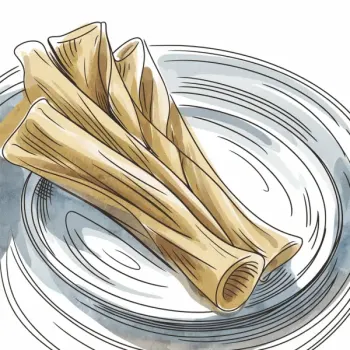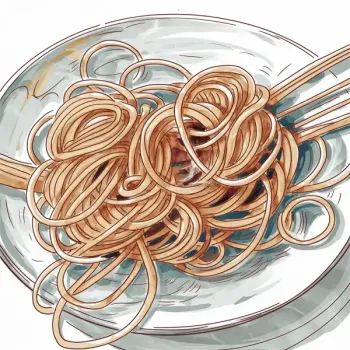Bucatini and spaghetti are both types of pasta, with the main difference being bucatini's hollow center compared to the solid form of spaghetti, affecting their texture and sauce interaction in cooking.

Bucatini is a type of pasta that is similar to spaghetti, but it has a hollow center. This thick, tubular pasta is often used in traditional Italian cooking and is particularly popular in the regions of Rome and Lazio.

Spaghetti is one of the most well-known pasta shapes. These long, round noodles are a staple in Italian cuisine and are used in a vast array of dishes worldwide. Unlike bucatini, spaghetti is solid with no hole running through it.
The main differences between bucatini and spaghetti lie in their shape and texture. Bucatini's hollow center allows it to hold onto sauces more effectively, providing a different mouthfeel and sauce-to-pasta ratio. In contrast, spaghetti's smooth surface is better suited for lighter, olive oil or tomato-based sauces. The texture of bucatini tends to be slightly chewier due to its thicker form, while spaghetti offers a quicker, more delicate bite.

Your ultimate Recipe Box, Meal Planner, and Cooking Class all in one
In classic dishes like Bucatini all'Amatriciana, the pasta's hollow shape perfectly traps the savory pancetta and tomato sauce. It's also ideal for dishes with thicker, creamier sauces like carbonara, where the sauce can cling to the interior and exterior of the pasta. Spaghetti is the go-to pasta for dishes like Spaghetti Aglio e Olio, Spaghetti al Pomodoro, and Spaghetti alla Puttanesca. Its smooth texture complements the delicate balance of garlic, olive oil, fresh tomatoes, and herbs without overwhelming the sauce.
For heartier meals like Bucatini with meat sauces or ragus, the pasta's structure holds up beautifully, offering a satisfying bite and ensuring each strand is coated with the rich, meaty sauce. Spaghetti, while also suitable for meat sauces, is famously paired with meatballs in Spaghetti and Meatballs, where the lighter pasta allows the focus to remain on the flavorful, tender meatballs.
Although less common, bucatini can be used in lighter dishes with fresh, vibrant ingredients. It pairs well with pesto or a primavera sauce, though the heartiness of the pasta may overshadow delicate flavors. Spaghetti shines in dishes like Spaghetti with Lemon and Arugula or a simple Cherry Tomato and Basil Pasta, where its lightness complements the fresh, zesty flavors without competing for attention.
Bucatini and Spaghetti are similar in nutritional value, with slight variations due to density and surface area.
| Nutrient | Bucatini ( per 2 oz serving (dry) ) | Spaghetti ( per 2 oz serving (dry) ) |
|---|---|---|
| Fat | 1g | 1g |
| Fiber | 2g | 2g |
| Sodium | 0mg | 0mg |
| Protein | 7g | 7g |
| Calories | 200 | 200 |
| Carbohydrates | 42g | 41g |
Yes, you can often use bucatini in place of spaghetti, but keep in mind the differences in texture and sauce absorption.
Bucatini is generally better for holding sauces, especially thicker ones, due to its hollow center.
Bucatini tends to be chewier than spaghetti because of its thicker size.
While they can be used interchangeably, spaghetti is traditionally used for spaghetti and meatballs, and it may better complement the dish's texture.
Yes, due to its thicker size, bucatini typically has a slightly longer cooking time than spaghetti.